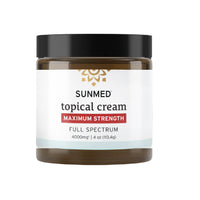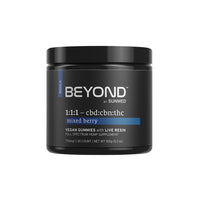The History and Benefits of Sativa
Learn all about sativa, its history and benefits, and why this type of cannabis is so popular with this guide from Sunmed.

If you have an interest in the hemp and cannabis industry, you may have heard of sativa.
Often associated with uplifting, mentally stimulating experiences, this popular type of cannabis has earned a strong following among individuals looking to support daily focus, creativity, and emotional balance.
However, the story of sativa goes far beyond recent popularity. Its roots are ancient, and its therapeutic benefits are deeply tied to the plant’s naturally occurring compounds, including cannabinoids and terpenes, that can offer a range of wellness benefits.
This guide will explore sativa’s history, unique botanical features, and its potential benefits while staying grounded in science and centered on the real-world ways people incorporate it into everyday life.
What are cannabis strains?
A cannabis strain is essentially a variety of the plant bred to express specific characteristics. These can include cannabinoid content (like CBD or THC), terpene profiles (which influence aroma and potential effects), and growth patterns.
Strains of cannabis are usually categorized as sativa, indica, or hybrid, though these terms mostly serve as a starting point for understanding potential effects. They don’t define outcomes on their own.
In hemp-derived wellness products, strain profiles are still relevant because they offer insight into how a product might make you feel.
A sativa-dominant strain, for example, might contain a terpene profile and cannabinoid blend aimed at supporting energy, clarity, and an uplifted mood. Hybrid strains may combine both calming and energizing elements, depending on their genetics.
The history of the sativa plant
Long before it became a modern wellness staple, the sativa plant was grown for fiber, spiritual ceremonies, and herbal rituals. Its relationship with humans dates back thousands of years, across continents and cultures.
Where is sativa from?
Sativa plants are native to equatorial regions like Southeast Asia, Central America, and parts of Africa. These areas offer warm temperatures, consistent sunlight, and long growing seasons.
The environmental conditions shaped how these plants developed over time: tall, lean stalks, narrow leaves, and a slower flowering cycle. These characteristics helped them thrive in bright, humid climates.
Because of their adaptability, sativa strains spread quickly along ancient trade routes. As they moved into new regions, they began to evolve and take on different characteristics. These naturally occurring variations are known as landrace strains. They’re the genetic foundation for many of the sativa-dominant hybrids we see today.
Early human use
Historical records show that hemp, specifically Cannabis sativa L., has been cultivated for more than 10,000 years. Early civilizations in China used the plant for textiles, rope, and food. In India, hemp held both medicinal and ceremonial importance. In these traditional practices, it was respected not just as a material resource, but as a plant with the potential to support body and mind.
Ancient texts from India describe uses of the plant in Ayurveda, a holistic healing system that still exists today. These uses may have included support for digestive discomfort, stress-related tension, and spiritual balance.
While the terminology and understanding of the body’s systems were different then, many of these uses align with what we now know about how cannabinoids interact with the ECS.
Evolution through cultivation and breeding
Over centuries, farmers and cultivators began selectively breeding these plants for specific traits like flavor, aroma, resilience, and desired effects.
As a result, sativa strains started to exhibit a broad range of terpene profiles and cannabinoid compositions. Today, sativa-dominant hemp products vary widely depending on how they’re grown, processed, and formulated.
Modern cultivation practices often aim to highlight sativa’s naturally energizing and mood-brightening qualities, while also balancing them with supportive cannabinoids like CBD or CBG to create well-rounded formulas.
It’s also important to understand that the original distinction between sativa and indica was botanical, not experiential. The traditional naming system is still used today, but researchers and formulators often look at the full profile of cannabinoids and cannabis terpenes to understand how a particular strain or product may affect the body.
Sativa vs. indica: what’s the difference?
You’ll often see products labeled sativa or indica, but what do these terms really mean? Originally, they referred to plant structure and growing patterns. Over time, they’ve come to suggest different types of experiences.
Sativa strains are generally known for being uplifting, while indica strains are associated with calming, body-focused effects. However, this distinction isn’t always so clear-cut.
Today, many modern strains are hybrids crossbred from various indica and sativa strains. What truly matters is the interaction between cannabinoids, terpenes, and your body’s unique chemistry.
What are the characteristics of sativa-dominant hemp strains?
If you’ve ever browsed a wellness shop and seen terms like “sativa-dominant” or “daytime support,” those products are likely formulated with terpene and cannabinoid combinations that aim to support mental clarity and focus.
Physical traits
Sativa plants are tall and elegant, with leaves that look more like long blades than the wide leaves often associated with other hemp varieties. Their longer flowering cycle requires more sunlight and time to mature, which makes them better suited to outdoor cultivation in warm climates.
Because of their height and long flowering time, they require more space and patience to grow, but they often yield large harvests when grown in the right environment.
Terpene and cannabinoid combinations
The uplifting effects of sativa-dominant products are often linked to their terpene content.
Limonene may support emotional wellness and a brighter outlook. Pinene is thought to promote clarity and alertness. These terpenes, combined with cannabinoids like CBD, CBG, or hemp-derived THC, can create synergistic effects that support mood and energy levels without overstimulation.
Traditionally, sativa strains have been found to contain higher levels of tetrahydrocannabinol (THC) and lower levels of cannabidiol (CBD). However, in hemp-derived products that meet legal thresholds (containing less than 0.3% THC), sativa-leaning options are often defined by their terpene profile and how they make users feel.
It’s important to remember that not everyone experiences sativa the same way. Your body’s response depends on several factors your current stress levels, time of day, hydration, diet, and even your mindset when using the product. That’s why listening to your body and starting with small serving sizes is always a good approach.
What are the potential benefits of sativa?
Sativa-dominant hemp products are often sought out by individuals looking to support emotional clarity, mental alertness, and motivation throughout the day. These effects of cannabis aren’t one-size-fits-all, but they are commonly associated with the specific terpene and cannabinoid profiles present in many sativa-leaning strains.
Let’s break down a few key areas where people report positive outcomes with sativa-based wellness routines.
Mood and emotional balance
Many people turn to sativa-rich products when they want to feel more uplifted or clear-headed during the day.
Some report that sativa formulas help ease occasional feelings of stress and promote a more balanced emotional state. This is especially relevant during times of heightened stress, where a sense of calm alertness can make a big difference in staying grounded and present.
Terpenes like limonene, commonly found in citrus fruits and some sativa strains, have been studied for their potential influence on mood and emotional wellness. Combined with other cannabinoids, this terpene may contribute to that “bright” or “motivated” feeling that sativa is known for.
Mental focus and daytime motivation
Sativa formulations are often used in the morning or early afternoon because they may support mental clarity and focus without the sluggishness that can come with more sedating strains. This makes them a popular option for people with active lifestyles, creative professions, or demanding daily schedules.
Instead of pushing your body into a state of alertness that can come with a crash, as caffeine might, hemp-derived cannabinoids can work with the endocannabinoid system (ECS) to help your body maintain balance and regulate its response to daily stressors. Some individuals find this particularly useful when they need to stay sharp and present for long periods.
Support for everyday discomfort
While indica-leaning products are sometimes associated with more body-based relief, sativa formulations can also play a role in helping the body unwind from tension. This could be useful for addressing minor head or neck tension, or supporting recovery after physical activity.
Cannabinoids like CBD and CBG, frequently included in full spectrum sativa products, are being studied for their potential to support the body’s natural recovery processes and to help soothe discomfort linked to stress or overuse.
Again, how you respond can vary, and it’s helpful to start small and see how your body reacts over time. Consistency is often key when it comes to plant-based wellness.
Creativity and productivity
Sativa has a reputation for inspiring creativity, and while this isn’t a guaranteed outcome, many users say they feel more open-minded, engaged, or curious after incorporating sativa-dominant cannabis products into their day.
Writers, designers, artists, and problem-solvers across industries often turn to these products not to escape, but to feel more in sync with their thinking process and daily tasks.
How does sativa work in the body?
Understanding how sativa works means understanding how the body’s endocannabinoid system functions. The ECS is a complex network of receptors, enzymes, and signaling molecules that helps regulate many important processes like mood, memory, energy balance, sleep, and immune function, to name a few.
The ECS includes two primary receptors: CB1 and CB2. CB1 receptors are concentrated in the brain and nervous system, while CB2 receptors are more common in immune tissues.
Cannabinoids from the hemp plant, such as CBD, CBG, and hemp-derived THC, interact with these receptors and can help the body maintain homeostasis, or balance.
In sativa-dominant strains, the cannabinoid and terpene profiles may be more likely to engage CB1 receptors in ways that support alertness and a positive mental state. This is one reason sativa products are often recommended for daytime use, while indica-leaning formulas may be more commonly used for nighttime routines.
Terpenes also play a big role. Compounds like pinene and terpinolene can support focus and mental clarity, and they often appear in higher concentrations in sativa-dominant hemp. This combination of cannabinoids and terpenes is often called the “entourage effect,” the idea that these compounds work better together than they do in isolation.
It’s worth noting that the ECS is highly individualized. Factors like genetics, stress levels, diet, and sleep habits can all affect how your body responds to sativa-based products.
That’s why it’s so important to use high-quality, third-party tested products and to give your body time to adjust before making any assumptions about what works best for you.
What to know about cultivating sativa
Behind every bottle of hemp oil or jar of gummies is a living plant that had to be grown under very specific conditions.
Sativa plants have distinct growth patterns and needs, and understanding how they’re cultivated can give you greater appreciation for the products you use.
Ideal growing conditions
Sativa plants thrive in warm, sunny environments with long daylight hours. They often grow taller and take longer to flower than indica strains, which makes them well-suited for outdoor farming in places with extended growing seasons. They typically need a lot of vertical space, ample airflow, and nutrient-rich, well-draining soil.
When grown under ideal conditions, sativa plants can produce impressive yields with high concentrations of valuable cannabinoids and terpenes. But they also require close attention, especially during flowering, when humidity control becomes critical to avoid mold and ensure clean, healthy buds.
Common cultivation challenges
One of the biggest challenges with sativa cultivation is managing the plant’s height. These plants can stretch dramatically during the flowering phase, making them harder to grow indoors or in limited vertical space. Techniques like topping, trellising, and low-stress training (LST) are often used to encourage lateral growth and improve light exposure across the canopy.
Sativa’s longer flowering cycle sometimes 12 to 16 weeks also requires patience and precision. Consistent lighting, proper humidity levels, and careful nutrient support are all essential to bringing out the plant’s full potential.
Sustainable farming practices, including organic cultivation and regenerative soil techniques, are increasingly being used to grow high-quality sativa hemp. These methods help preserve the plant’s natural integrity and reduce the risk of contaminants, which supports better outcomes for both people and the planet.
Is sativa legal?
Hemp-derived sativa products, which are those containing less than 0.3% THC by dry weight, are federally legal under the 2018 Farm Bill in the United States. However, individual states may have additional restrictions or labeling requirements, so it’s important to stay informed about local laws.
Are there any health risks to using sativa?
Even with legal access, using hemp products responsibly matters. Here are a few reminders to help you get the most from your experience while minimizing potential side effects:
- Start low and go slow. Everyone’s body is different. Serving size, timing, and consistency all impact how you may feel.
- Read third-party lab reports. These confirm the product’s cannabinoid content and screen for pesticides, heavy metals, and other unwanted substances.
- Check the cannabinoid profile. Avoid making assumptions based solely on the strain name. Look at the full formulation, especially terpene content and how it's meant to be used (daytime vs. nighttime, for example).
- Stay hydrated and nourish your body. Hydration and proper nutrition support your ECS and can help optimize how your body processes cannabinoids.
Lastly, it’s always a good idea to talk to a healthcare provider if you’re taking medications or managing a health condition. Hemp-derived cannabinoids can interact with other substances, and professional guidance can ensure your wellness routine supports your overall goals.
What to look for in sativa products
Not all hemp products are created equal. From how the plant is grown to how it's extracted and formulated, every step affects purity, potency, and consistency. That’s why sourcing and transparency are so important in wellness.
Look for products that are:
- Derived from organically grown hemp
- Third-party tested for quality and safety
- Clearly labeled with serving size information
- Backed by transparent educational resources to help you understand what you’re taking
Whether you're new to sativa-rich formulas or already using hemp in your daily routine, choosing products that prioritize clean ingredients and reliable science can help you feel more confident about what you're putting into your body.
The bottom line
We believe plant-based wellness should feel empowering not confusing. That’s why at Sunmed, we create premium, hemp-derived products made with clean ingredients, tested for quality, and designed to support your well-being in a real, tangible way.
Our full spectrum and broad spectrum offerings are rooted in science and built to align with how your body naturally works. Every formula we offer is third-party tested, crafted for consistency, and developed to meet real wellness goals: energy, recovery, sleep, stress balance, and more.
We’re here to make cannabinoid wellness more accessible and approachable for everyone, whether you’re exploring sativa for the first time or refining a routine that’s already working for you. With the right information and trustworthy products, your wellness journey can be something you actually look forward to.
This statement has not been evaluated by the Food & Drug Administration. This product is not intended to diagnose, treat, cure, or prevent any disease.
Sources:
Cannabis (Weed) Strains: Types, Effects, & Differences | Web MD
Cannabis sativa: The Plant of the Thousand and One Molecules | PMC













